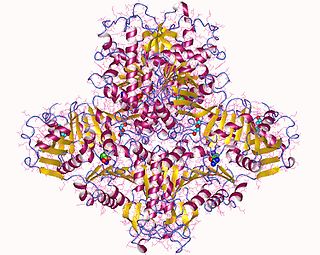See also
Index of enzymes associated with the same name
This set index page lists enzyme articles associated with the same name. If an internal link led you here, you may wish to change the link to point directly to the intended article.
N-acetylglutamate synthetase may refer to:

Histone acetyltransferases (HATs) are enzymes that acetylate conserved lysine amino acids on histone proteins by transferring an acetyl group from acetyl-CoA to form ε-N-acetyllysine. DNA is wrapped around histones, and, by transferring an acetyl group to the histones, genes can be turned on and off. In general, histone acetylation increases gene expression.

Choline acetyltransferase is a transferase enzyme responsible for the synthesis of the neurotransmitter acetylcholine. ChAT catalyzes the transfer of an acetyl group from the coenzyme acetyl-CoA to choline, yielding acetylcholine (ACh). ChAT is found in high concentration in cholinergic neurons, both in the central nervous system (CNS) and peripheral nervous system (PNS). As with most nerve terminal proteins, ChAT is produced in the body of the neuron and is transported to the nerve terminal, where its concentration is highest. Presence of ChAT in a nerve cell classifies this cell as a "cholinergic" neuron. In humans, the choline acetyltransferase enzyme is encoded by the CHAT gene.

N-Acetylglutamic acid (also referred to as N-acetylglutamate, abbreviated NAG, chemical formula C7H11NO5) is biosynthesized from glutamate and acetylornithine by ornithine acetyltransferase, and from glutamic acid and acetyl-CoA by the enzyme N-acetylglutamate synthase. The reverse reaction, hydrolysis of the acetyl group, is catalyzed by a specific hydrolase. It is the first intermediate involved in the biosynthesis of arginine in prokaryotes and simple eukaryotes and a regulator in the process known as the urea cycle that converts toxic ammonia to urea for excretion from the body in vertebrates.

Dihydrolipoyl transacetylase is an enzyme component of the multienzyme pyruvate dehydrogenase complex. The pyruvate dehydrogenase complex is responsible for the pyruvate decarboxylation step that links glycolysis to the citric acid cycle. This involves the transformation of pyruvate from glycolysis into acetyl-CoA which is then used in the citric acid cycle to carry out cellular respiration.

N-acetyltransferase (NAT) is an enzyme that catalyzes the transfer of acetyl groups from acetyl-CoA to arylamines, arylhydroxylamines and arylhydrazines. They have wide specificity for aromatic amines, particularly serotonin, and can also catalyze acetyl transfer between arylamines without CoA. N-acetyltransferases are cytosolic enzymes found in the liver and many tissues of most mammalian species, except the dog and fox, which cannot acetylate xenobiotics.

N-Acetylglutamate synthase (NAGS) is an enzyme that catalyses the production of N-acetylglutamate (NAG) from glutamate and acetyl-CoA.

N-Acetylglutamate synthase deficiency is an autosomal recessive urea cycle disorder.

Acetyltransferase is a type of transferase enzyme that transfers an acetyl group, through a process called acetylation. Acetylation serves as a modification that can profoundly transform the functionality of a protein by modifying various properties like hydrophobicity, solubility, and surface attributes. These alterations have the potential to influence the protein's conformation and its interactions with substrates, cofactors, and other macromolecules. The image to the right shows the basic structure of an acetyl group, where R is a variable indicates the remainder of the molecule to which the acetyl group is attached.

Aralkylamine N-acetyltransferase (AANAT), also known as arylalkylamine N-acetyltransferase or serotonin N-acetyltransferase (SNAT), is an enzyme that is involved in the day/night rhythmic production of melatonin, by modification of serotonin. It is in humans encoded by the ~2.5 kb AANAT gene containing four exons, located on chromosome 17q25. The gene is translated into a 23 kDa large enzyme. It is well conserved through evolution and the human form of the protein is 80 percent identical to sheep and rat AANAT. It is an acetyl-CoA-dependent enzyme of the GCN5-related family of N-acetyltransferases (GNATs). It may contribute to multifactorial genetic diseases such as altered behavior in sleep/wake cycle and research is on-going with the aim of developing drugs that regulate AANAT function.

N-acetyltransferase 2 , also known as NAT2, is an enzyme which in humans is encoded by the NAT2 gene.
In enzymology, an acetylglutamate kinase is an enzyme that catalyzes the chemical reaction:

N-alpha-acetyltransferase 10 (NAA10) also known as NatA catalytic subunit Naa10 and arrest-defective protein 1 homolog A (ARD1A) is an enzyme subunit that in humans is encoded NAA10 gene. Together with its auxiliary subunit Naa15, Naa10 constitutes the NatA complex that specifically catalyzes the transfer of an acetyl group from acetyl-CoA to the N-terminal primary amino group of certain proteins. In higher eukaryotes, 5 other N-acetyltransferase (NAT) complexes, NatB-NatF, have been described that differ both in substrate specificity and subunit composition.

Heparan-α-glucosaminide N-acetyltransferase is an enzyme that in humans is encoded by the HGSNAT gene.
Tiglyl-CoA is an intermediate in the metabolism of isoleucine. It is an inhibitor of N-acetylglutamate synthetase.
Hexen may refer to:
Acetylglutamate synthetase may refer to:
N-acetyl-L-glutamate synthetase may refer to:
Sialate O-acetyltransferase may refer to:
Serotonin acetyltransferase may refer to: